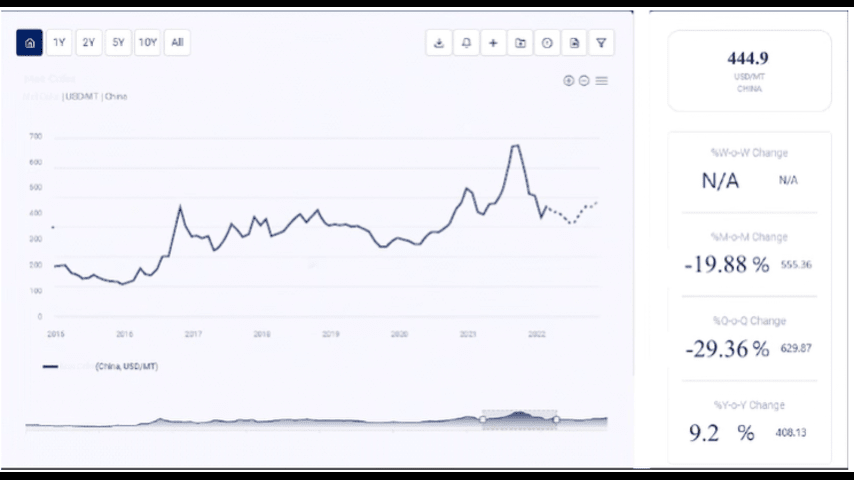
Olive Oil Price Chart: Analysis and Trends for 2024
Olive oil is a staple in many households and an essential ingredient in various cuisines around the world. Its price trends are of significant interest to consumers, producers, and traders. This article provides a comprehensive analysis of olive oil price chart, supported by historical data and forecasts for 2024. We will explore the factors influencing these trends and provide a detailed examination of the olive oil market dynamics.
Historical Overview of Olive Oil Prices
Long-Term Price Trends
Olive oil prices have historically been volatile, influenced by a range of factors including climatic conditions, agricultural practices, geopolitical events, and market demand. Over the past decade, olive oil prices have seen both significant peaks and troughs.
In the early 2010s, olive oil prices were relatively stable, averaging around €2.50 to €3.00 per kilogram. However, starting from 2015, prices began to rise sharply due to a combination of poor harvests in major producing countries like Spain and Italy and increased global demand. By 2017, prices had peaked at around €4.00 to €4.50 per kilogram.
Enquire For Regular Prices: https://www.procurementresource.com/resource-center/olive-oil-price-trends/pricerequest
Recent Price Movements (2018-2023)
From 2018 onwards, olive oil prices experienced fluctuations primarily driven by weather conditions and supply chain disruptions. In 2018 and 2019, favorable weather conditions led to bumper harvests, causing prices to drop to around €2.00 to €2.50 per kilogram. However, starting in late 2020, prices began to rise again due to drought conditions in Southern Europe and increased production costs.
In 2022 and 2023, prices surged to unprecedented levels, reaching up to €5.00 to €6.00 per kilogram. This was largely due to severe droughts in Spain, which is the largest producer of olive oil globally, and rising energy costs that affected production and transportation.
Olive Oil Price Trends in 2023
Analysis of 2023 Price Data
The year 2023 was marked by significant volatility in olive oil prices. The average price of olive oil increased by approximately 50% compared to 2022. The primary drivers of this price increase were:
- Adverse Weather Conditions: Prolonged droughts and heatwaves in key olive-producing regions, especially in Spain and Italy, led to poor harvests and reduced supply.
- Rising Production Costs: Increased costs for energy, labor, and agricultural inputs contributed to higher production costs, which were passed on to consumers.
- High Global Demand: Despite rising prices, global demand for olive oil remained strong, particularly in Europe and North America.
Monthly Price Breakdown
- January 2023: Prices started the year at around €4.50 per kilogram, reflecting the tight supply from the previous year.
- March 2023: Prices rose to approximately €5.00 per kilogram as reports of poor harvests from Spain began to impact the market.
- June 2023: The onset of summer saw prices peak at €5.50 per kilogram, driven by ongoing drought conditions and increased demand for summer cooking.
- September 2023: Prices stabilized at around €5.00 per kilogram as the new harvest season approached, offering some hope of improved supply.
- December 2023: The year ended with prices around €5.20 per kilogram, still reflecting high production costs and tight supply conditions.
Factors Influencing Olive Oil Prices
Environmental Factors
Climate change has emerged as a critical factor influencing olive oil production. The Mediterranean region, where most of the world’s olive oil is produced, is particularly vulnerable to climate variability. Prolonged droughts, unexpected frosts, and extreme heat events can severely impact olive yields. For example, the severe droughts in Spain in 2022 and 2023 significantly reduced olive oil output, leading to higher prices.
Agricultural Practices
Agricultural practices, including the adoption of modern irrigation techniques and pest control measures, also affect olive oil production costs and yields. In recent years, there has been a push towards more sustainable and organic farming practices. While these practices are beneficial for the environment, they often come with higher production costs that can lead to higher prices for consumers.
Geopolitical and Economic Factors
Geopolitical tensions and economic conditions in major producing countries can also influence olive oil prices. Trade policies, tariffs, and export restrictions can create market uncertainties and affect global supply chains. Additionally, fluctuations in currency exchange rates can impact the competitiveness of olive oil in international markets.
Market Demand
Consumer preferences and market demand play a crucial role in determining olive oil prices. In recent years, there has been a growing trend towards healthy eating and the use of natural products, which has boosted demand for high-quality extra virgin olive oil. Seasonal demand variations, such as increased consumption during the holiday season, can also influence prices.
Price Forecast for 2024
Expected Price Range
Analysts predict that olive oil prices will continue to be volatile in 2024, with an expected trading range between €7.00 and €12.00 per kilogram. Several factors will contribute to this outlook:
- Weather Conditions: The weather in the Mediterranean region will be a key determinant. Improved weather conditions could lead to better harvests and stabilize prices, while continued droughts could exacerbate supply shortages and drive prices higher.
- Production Costs: Rising costs for energy, labor, and agricultural inputs are likely to keep production costs high, supporting elevated price levels.
- Global Demand: Strong demand for olive oil, especially from health-conscious consumers in Europe and North America, will continue to support prices.
Strategies for Stakeholders
For Consumers
Consumers can expect to face higher prices for olive oil in 2024. To manage costs, consumers may consider:
- Bulk Purchasing: Buying olive oil in bulk during sales or promotional periods can help reduce the cost per unit.
- Alternative Oils: Exploring alternative cooking oils, such as sunflower or canola oil, can provide cost-effective options for everyday use, while reserving olive oil for specific dishes.
For Producers
Producers should focus on strategies to mitigate the impact of rising production costs and climate variability:
- Sustainable Practices: Investing in sustainable farming practices, such as efficient irrigation systems and integrated pest management, can improve yields and reduce long-term costs.
- Diversification: Diversifying crop production and exploring value-added products, such as flavored or organic olive oils, can open new market opportunities and enhance profitability.
For Traders and Investors
Traders and investors should monitor market trends and geopolitical developments to make informed decisions:
- Market Analysis: Keeping abreast of market reports and forecasts will help identify buying and selling opportunities.
- Risk Management: Utilizing financial instruments such as futures contracts can help hedge against price volatility and manage risk.
Conclusion
The olive oil market is poised for continued volatility in 2024, driven by a complex interplay of environmental, economic, and market factors. While high prices are likely to persist, there are opportunities for stakeholders to navigate these challenges through strategic planning and adaptation. By understanding the factors influencing olive oil prices and staying informed about market trends, consumers, producers, and traders can make better decisions and capitalize on emerging opportunities in the olive oil market.


